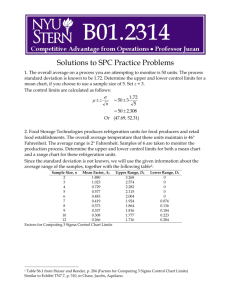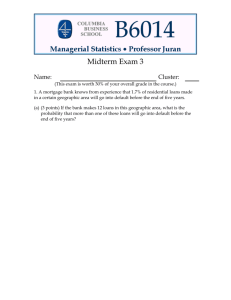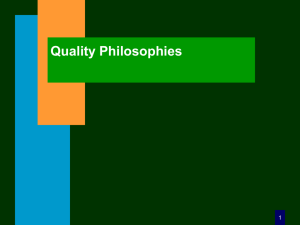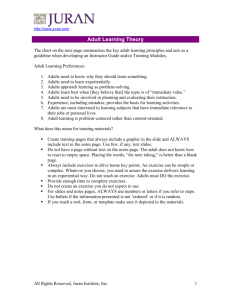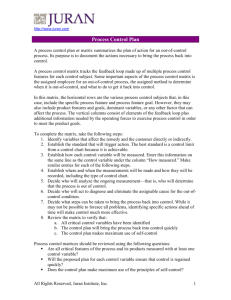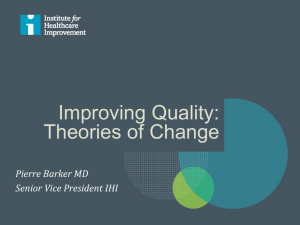om-08a - NYU Stern School of Business
advertisement
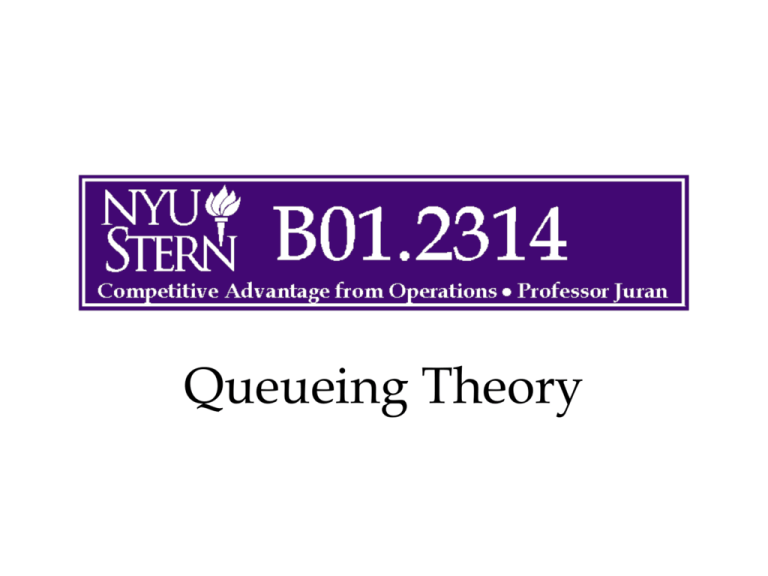
Queueing Theory Overview •Basic definitions and metrics •Examples of some theoretical models Operations -- Prof. Juran 2 Basic Queueing Theory A set of mathematical tools for the analysis of probabilistic systems of customers and servers. Can be traced to the work of A. K. Erlang, a Danish mathematician who studied telephone traffic congestion in the first decade of the 20th century. Applications: Service Operations Manufacturing Systems Analysis Operations -- Prof. Juran 3 Agner Krarup Erlang (1878 - 1929) Operations -- Prof. Juran 4 Components of a Queuing System Service Process Queue or Waiting Line Arrival Process Servers Exit Customer Population Sources Population Source Finite Infinite Example: Number of machines needing repair when a company only has three machines. Example: The number of people who could wait in a line for gasoline. Service Pattern Service Pattern Constant Example: Items coming down an automated assembly line. Variable Example: People spending time shopping. Examples of Queue Structures Single Phase Multiphase Single Channel One-person barber shop Car wash Multichannel Bank tellers’ windows Hospital admissions Balking and Reneging No Way! Balking: Arriving, but not joining the queue No Way! Reneging: Joining the queue, then leaving Suggestions for Managing Queues 1. Determine an acceptable waiting time for your customers 2. Try to divert your customer’s attention when waiting 3. Inform your customers of what to expect 4. Keep employees not serving the customers out of sight 5. Segment customers Suggestions for Managing Queues 6. Train your servers to be friendly 7. Encourage customers to come during the slack periods 8. Take a long-term perspective toward getting rid of the queues Source: Katz, Larson, Larson (1991) Arrival Rate refers to the average number of customers who require service within a specific period of time. A Capacitated Queue is limited as to the number of customers who are allowed to wait in line. Customers can be people, work-in-process inventory, raw materials, incoming digital messages, or any other entities that can be modeled as lining up to wait for some process to take place. A Queue is a set of customers waiting for service. Operations -- Prof. Juran 12 Queue Discipline refers to the priority system by which the next customer to receive service is selected from a set of waiting customers. One common queue discipline is first-in-first-out, or FIFO. A Server can be a human worker, a machine, or any other entity that can be modeled as executing some process for waiting customers. Service Rate (or Service Capacity) refers to the overall average number of customers a system can handle in a given time period. Stochastic Processes are systems of events in which the times between events are random variables. In queueing models, the patterns of customer arrivals and service are modeled as stochastic processes based on probability distributions. Utilization refers to the proportion of time that a server (or system of servers) is busy handling customers. Operations -- Prof. Juran 13 In the literature, queueing models are described by a series of symbols and slashes, such as A/B/X/Y/Z, where •A indicates the arrival pattern, •B indicates the service pattern, •X indicates the number of parallel servers, •Y indicates the queue’s capacity, and •Z indicates the queue discipline. We will be concerned primarily with the M/M/1 queue, in which the letter M indicates that times between arrivals and times between services both can be modeled as being exponentially distributed. The number 1 indicates that there is one server. We will also study some M/M/s queues, where s is some number greater than 1. Operations -- Prof. Juran 14 Performance Measure Number of Customers in the System Random Variable N Expected Value L Number of Customers in the Queue Number of Customers in Service Time Spent in the System Nq Ns T Lq Ls W Time Spent in the Queue Time Spent in Service Tq Ts Wq Ws System Parameters S Number of Servers Arrival Rate (number per unit of time) Service Rate (number per unit of time) Utilization Factor Symbol (Greek letter lambda) (Greek letter mu) (Greek letter rho) Probability Measure Pn Probability of n customers in the system Pw Probability of having to wait Be careful! These symbols can vary across different books, professors, etc. Operations -- Prof. Juran 15 General (all queue models) Single Phase Infinite Source FCFS Discipline Infinite Queue Length Single Server M/D/1 (Model 2) Operations -- Prof. Juran M/M/1 (Model 1) M/M/S M/M/2 (Model 3) 16 General Formulas John D. C. Little 1928 — Operations -- Prof. Juran 17 The single most important formula in queueing theory is called Little’s Law: L Average time in system W Average customers in system L W ii Arrival Rate L W iii i Little’s Law applies to any subsystem as well. For example, Average time in queue Operations -- Prof. Juran Wq Lq iv 18 L as a Function of Rho 200 180 160 140 120 L 100 80 60 40 20 0 0 0.1 0.2 0.3 0.4 0.5 0.6 0.7 0.8 0.9 1 Rho Operations -- Prof. Juran 19 General Single-Server Formulas Average time in system Average time in queue Operations -- Prof. Juran W Wq Wq Lq 1 v vi 20 •There aren’t many general queueing results (see Larry Robinson’s sheet for some of them). •Much of queueing theory consists of making assumptions about the specific type of queue. •The class of models with the most analytical results is the category in which the arrival process and/or service process follows an exponential distribution. Operations -- Prof. Juran 21 Example: General Formula 𝐼≅ I c Ci Cp 𝜌 2 𝑐+1 1−𝜌 × 𝐶𝑖 2 + 𝐶𝑝 2 2 Average line length Number of servers Coefficient of variation; arrival process Coefficient of variation; service process Coefficient of Variation: 𝜎 𝐶𝑉 = 𝜇 Operations -- Prof. Juran 22 Andrey Markov (Андрей Андреевич Марков) 1856 — 1922 Operations -- Prof. Juran 23 Probability The Exponential Distribution PT t e t Time between Events T is a continuous positive random number. t is a specific value of T. Operations -- Prof. Juran 24 Example: If the average time between arrivals is 45 seconds and inter-arrival times are exponentially distributed, what is the probability that two sequential arrivals will be more than 60 seconds apart? Remember lambda is in “events per time unit”, so PT 60 1 0.02222 45 e t 2.7180.02222*60 0.2636 Operations -- Prof. Juran 25 PT 60 0.2636 Operations -- Prof. Juran 26 Here’s how to do this calculation in Excel: 1 2 3 4 D E lambda t 0.02222 60 0.2636 F G =1/45 =EXP(-E2*E3) The EXP function raises e to the power of whatever number is in parentheses. Operations -- Prof. Juran 27 Remember that the exponential distribution has a really long tail. In probability-speak, it has strong right-skewness, and there are outliers with very large values. In fact, the probability of any one inter-event time being longer than the mean inter-event time is: 1 P T 0.3679 In other words, only 37% of inter-event times will be longer than the expected value of the inter-event times. This counter-intuitive result is because some of the 37% are really, really long. Operations -- Prof. Juran 28 1 P T Operations -- Prof. Juran 0.3679 29 Other Facts about the Exponential Distribution • “Memoryless” property: The expected time until the next event is independent of how long it’s been since the previous event • The mean is equal to the standard deviation (so the CV is always 1) • Analogous to the discrete Geometric distribution Operations -- Prof. Juran 30 Siméon Denis Poisson 1781 — 1840 Operations -- Prof. Juran 31 If the random time between events is exponentially distributed, then the random number of events in any given period of time follows a Poisson process. A Poisson random variable is discrete. The number of events n (i.e. arrivals) in a certain space of time must be an integer. n is a positive random integer (sometimes zero). Operations -- Prof. Juran 32 t e Pt n n t n! In English: The probability of exactly n events within t time units. Operations -- Prof. Juran 33 Poisson distribution; λ = 7.5 0.16 t e Pt n 0.14 n 0.12 n! 0.10 Probability t 0.08 0.06 0.04 0.02 0.00 0 1 2 3 4 5 6 7 8 9 10 11 12 13 14 15 16 17 18 19 20 21 22 23 24 25 Number of Events in 1 Time Unit Operations -- Prof. Juran 34 22 23 24 25 26 27 28 29 30 31 32 33 34 35 36 37 38 39 E lambda F G 0 1 2 3 4 5 6 7 8 9 10 11 12 13 14 15 0.0005531 0.0041481 0.0155555 0.0388887 0.0729164 0.1093746 0.1367182 0.1464838 0.1373286 0.1144405 0.0858304 0.0585207 0.0365754 0.0211012 0.0113042 0.0056521 E lambda F 0 1 2 3 4 5 6 7 8 9 10 11 12 13 14 15 0.0005531 0.0047012 0.0202567 0.0591455 0.1320619 0.2414365 0.3781547 0.5246385 0.6619671 0.7764076 0.8622380 0.9207587 0.9573341 0.9784353 0.9897396 0.9953917 H I 7.5 0.16 0.14 =POISSON(E25,$F$22,0) Probability 0.12 0.10 0.08 0.06 0.04 0.02 0.00 0 1 2 3 4 5 6 7 8 9 10 11 12 13 14 15 16 17 18 19 20 21 22 23 24 25 Number of Events G H I 7.5 1.0 0.9 =POISSON(E25,$F$22,1) Operations -- Prof. Juran 0.8 Probability 22 23 24 25 26 27 28 29 30 31 32 33 34 35 36 37 38 39 0.7 0.6 0.5 0.4 0.3 0.2 0.1 0.0 0 1 2 3 4 5 6 7 8 9 10 11 12 13 14 15 16 17 18 19 20 21 22 23 24 25 Number of Events 35 The Excel formula is good for figuring out the probability distribution for the number of events in one time unit. Here is a more general approach: H 13 14 15 16 17 18 n lambda e t I 15 7.5 2.718 3 0.02481 J K L M N =EXP(1) =(((I14*I16)^I13)*((I15)^(-I14*I16)))/(FACT(I13)) This gives the probability of exactly fifteen events in three time units, when the average number of events per time unit is 7.5. You could adapt the Excel formula for general purposes by re-defining what “one time unit” means. Operations -- Prof. Juran 36 Waiting Line Models Model 1 2 3 4 Layout Single Channel Single Channel Multichannel Single or Multi Source Population Infinite Infinite Infinite Finite Service Pattern Exponential Deterministic Exponential Exponential These four models share the following characteristics: •Single Phase •Poisson Arrivals •FCFS Discipline •Unlimited Queue Capacity Model 1 (M/M/1) Formulas Utilization Average customers in the system L L Operations -- Prof. Juran vii 1 viii ix 38 Model 1 (M/M/1) Formulas Average queue length Lq 1 2 Lq 1 2 Lq Operations -- Prof. Juran x xi xii 39 Model 1 (M/M/1) Formulas Average time in system W 1 xiii Average time in queue Wq xiv Wq Operations -- Prof. Juran L xv 40 Model 1 (M/M/1) Formulas Probability of a specific number of customers in the system Probability of no wait Operations -- Prof. Juran Pn 1 n xvi P N n n xvii P0 1 xviii 41 Example: Model 1 (M/M/1) Assume a drive-up window at a fast food restaurant. Customers arrive at the rate of 25 per hour. The employee can serve one customer every two minutes. Assume Poisson arrival and exponential service rates. Determine: A. What is the average utilization of the employee? B. What is the average number of customers in line? C. What is the average number of customers in the system? D. What is the average waiting time in line? E. What is the average waiting time in the system? F. What is the probability that exactly two cars will be in the system? Example: Model 1 (M/M/1) A) What is the average utilization of the employee? = 25 cust/hr 1 customer = = 30 cust/hr 2 mins (1hr/60 mins) 25 cust/hr = = = .8333 30 cust/hr Example: Model 1 B) What is the average number of customers in line? (25) Lq = = = 4.167 ( - ) 30(30 - 25) 2 2 C) What is the average number of customers in the system? 25 L= = =5 - (30 - 25) Example: Model 1 D) What is the average waiting time in line? Wq = Lq = .1667 hrs = 10 mins E) What is the average time in the system? W= L = .2 hrs = 12 mins Example: Model 1 F) What is the probability that exactly two cars will be in the system (one being served and the other waiting in line)? λ λ pn 1- μ μ n 2 25 25 p2 1- 0.1157 30 30 M/D/1 Formulas Average queue length 2 Lq 2 xix Average customers in the system L Lq xx Operations -- Prof. Juran 47 Example: Model 2 (M/D/1) An automated pizza vending machine heats and dispenses a slice of pizza in 4 minutes. Customers arrive at an average rate of one every 6 minutes, with the arrival rate exhibiting a Poisson distribution. Determine: A) The average number of customers in line. B) The average total waiting time in the system. Example: Model 2 A) The average number of customers in line. (10) Lq = = = .6667 2 ( - ) (2)(15)(15 - 10) 2 2 B) The average total waiting time in the system. 10 Wq = = = .06667 hrs = 4 mins 2 ( - ) 2( 15)( 15 - 10) 1 1 W = Wq + = .06667 hrs + = .1333 hrs = 8 mins 15/hr M/M/S Formulas Utilization S xvii Average customers in system L Lq xviii Lq formula is nasty; best to use the Excel template or the table in the book. Operations -- Prof. Juran 50 Example: Model 3 (M/M/2) Recall the Model 1 example: • Drive-up window at a fast food restaurant. • Customers arrive at the rate of 25 per hour. • The employee can serve one customer every two minutes. • Assume Poisson arrival and exponential service rates. If an identical window (and an identically trained server) were added, what would the effects be on the average number of cars in the system and the total time customers wait before being served? Example: Model 3 Average number of cars in the system Lq = 0.176 (Exhibit TN7.11 - - using linear interpolation) 25 L = Lq + = .176 + = 1.009 30 Total time customers wait before being served Lq .176 customers Wq = = = .007 hours ( 1 minute) 25 customers/min M/M/s Calculator (Mms.xls) A 1 mms.xls 2 3 4 Inputs: 5 lambda 6 mu 7 8 9 10 11 12 13 14 15 Outputs: 16 s 17 0 18 1 19 2 20 3 21 4 22 5 23 6 24 7 25 8 26 9 27 10 B C D M/M/s Queueing Formula Spreadsheet E F G H Definitions of terms: 25 30 Lq 4.1667 0.1751 0.0222 0.0029 0.0003 0.0000 0.0000 0.0000 0.0000 0.0000 Operations -- Prof. Juran lambda = arrival rate mu = service rate s = number of servers Lq = average number in the queue L = average number in the system Wq = average wait in the queue W = average wait in the system P(0) = probability of zero customers in the system P(delay) = probability that an arriving customer has to wait L 5.0000 1.0084 0.8555 0.8362 0.8337 0.8334 0.8333 0.8333 0.8333 0.8333 Wq W 0.1667 0.0070 0.0009 0.0001 0.0000 0.0000 0.0000 0.0000 0.0000 0.0000 0.2000 0.0403 0.0342 0.0334 0.0333 0.0333 0.0333 0.0333 0.0333 0.0333 P(0) 0.1667 0.4118 0.4321 0.4343 0.4346 0.4346 0.4346 0.4346 0.4346 0.4346 P(delay) 0.8333 0.2451 0.0577 0.0110 0.0017 0.0002 0.0000 0.0000 0.0000 0.0000 Utilization 0.8333 0.4167 0.2778 0.2083 0.1667 0.1389 0.1190 0.1042 0.0926 0.0833 53 Finite Queuing: Model 4 Finite Notation: D = Probability that an arrival must wait in line F = Efficiency factor, a measure of the effect of having to wait in line Ls = Average number of units being served J = Source population less those being served Lq = Average number of units in line S = Number of servers Operations -- Prof. Juran 54 n = Number of customers in the system N = Number of customers in the source population P = Probability of exactly n customers in the system T = Average time to perform service U = Average time between service (per customer) W = Average waiting time in line X = Service factor = T (the proportion of time a customer is in service) T U Operations -- Prof. Juran 55 The copy center of an electronics firm has four copy machines that are all serviced by a single technician. Every two hours, on average, the machines require adjustment. The technician spends an average of 10 minutes per machine when adjustment is required. Assuming Poisson arrivals and exponential service, how many machines are “down” (on average)? N, the number of machines in the population = 4 M, the number of repair people = 1 T, the time required to service a machine = 10 minutes U, the average time between service = 2 hours T 10 min X= = .077 T + U 10 min + 120 min From Table TN7.12, F = .980 (Interpolation) Lq = N(1 - F) = 4(1 - 0.980) = 0.08 machines (From Table TN6.11: F = 0.980 , using interpolation) Ls = FNX = 0.980(4)(0.077) = 0.302 Average number of machines down = Lq + Ls = 0.382 machines Note: TN7 uses L instead of Lq, and H instead of Ls Operations -- Prof. Juran 58 Example: Airport Security Each airline passenger and his or her luggage must be checked to determine whether he or she is carrying weapons onto the airplane. Suppose that at Gotham City Airport, an average of 10 passengers per minute arrive, where interarrival times are exponentially distributed. To check passengers for weapons, the airport must have a checkpoint consisting of a metal detector and baggage X-ray machine. Whenever a checkpoint is in operation, two employees are required. These two employees work simultaneously to check a single passenger. A checkpoint can check an average of 12 passengers per minute, where the time to check a passenger is also exponentially distributed. Operations -- Prof. Juran 59 Why is an M/M/l, not an M/M/2, model relevant here? Operations -- Prof. Juran 60 What is the probability that a passenger will have to wait before being checked for weapons? Operations -- Prof. Juran 61 On average, how many passengers are waiting in line to enter the checkpoint? Operations -- Prof. Juran 62 On average, how long will a passenger spend at the checkpoint (including waiting time in line)? Operations -- Prof. Juran 63 Difficulties with Analytical Queueing Models • Using expected values, we can get some results • Easy to set up in a spreadsheet • It is dangerous to replace a random variable with its expected value • Analytical methods (beyond expected values) require difficult mathematics, and must be based on strict (perhaps unreasonable) assumptions Operations -- Prof. Juran 64 Summary •Basic definitions and metrics •Examples of some theoretical models Operations -- Prof. Juran 65

